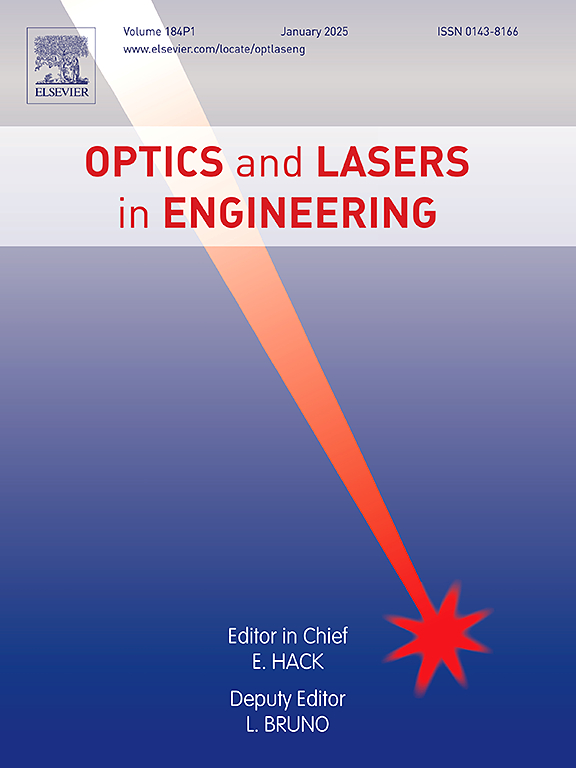Co-phase error detection of segmented mirrors based on polarization-multiplexing multi-wavelength dynamic interferometry
IF 3.5
2区 工程技术
Q2 OPTICS
引用次数: 0
Abstract
The performance of large-aperture telescopes of segmented mirrors is primarily determined by the co-phase metrics among segmented mirrors. This paper proposes a novel method, based on polarization-multiplexing multi-wavelength dynamic interferometry, to measure co-phase errors of segmented mirrors. This method merges two light sources into the orthogonally polarized beams serving as test and reference beams. These beams are regrouped before being recorded, allowing two polarization cameras to respectively record the interferograms at different wavelengths. Consequently, this approach enables simultaneous work for two light sources in a single optical path without crosstalk. By integrating spatial phase shifting, two polarization cameras each capture four phase-shifted interferograms in a single shot. The analysis of error amplification due to environmental disturbance demonstrated the superior environmental insensitivity capability of the proposed method. The feasibility of the proposed method was validated using the experimentally constructed interferometer, which adjusted the piston error of the two segmented mirrors from 40.6 μm to 9.73 nm. This approach minimizes errors caused by environmental disturbance and eliminates the need for high-speed response hardware and their mutual synchronization, offering an effective and economical solution for addressing co-phase errors in large-aperture telescopes of segmented mirrors.
基于偏振复用多波长动态干涉的分段反射镜共相误差检测
大口径分段镜望远镜的性能主要取决于分段镜之间的共相度量。提出了一种基于偏振复用多波长动态干涉测量的分段反射镜共相误差测量方法。该方法将两个光源合并成正交偏振光束,作为测试光束和参考光束。这些光束在被记录之前被重新组合,允许两个偏振相机分别记录不同波长的干涉图。因此,这种方法可以在单个光路中同时工作两个光源,而不会产生串扰。通过整合空间相移,两台偏振相机分别在一次拍摄中捕获四个相移干涉图。对环境干扰引起的误差放大进行了分析,结果表明该方法具有良好的环境不敏感能力。通过实验搭建的干涉仪,将两段镜的活塞误差从40.6 μm调整到9.73 nm,验证了该方法的可行性。该方法最大限度地减少了环境干扰引起的误差,消除了高速响应硬件及其相互同步的需要,为解决大口径分段镜望远镜的共相误差提供了一种有效而经济的解决方案。
本文章由计算机程序翻译,如有差异,请以英文原文为准。
求助全文
约1分钟内获得全文
求助全文
来源期刊

Optics and Lasers in Engineering
工程技术-光学
CiteScore
8.90
自引率
8.70%
发文量
384
审稿时长
42 days
期刊介绍:
Optics and Lasers in Engineering aims at providing an international forum for the interchange of information on the development of optical techniques and laser technology in engineering. Emphasis is placed on contributions targeted at the practical use of methods and devices, the development and enhancement of solutions and new theoretical concepts for experimental methods.
Optics and Lasers in Engineering reflects the main areas in which optical methods are being used and developed for an engineering environment. Manuscripts should offer clear evidence of novelty and significance. Papers focusing on parameter optimization or computational issues are not suitable. Similarly, papers focussed on an application rather than the optical method fall outside the journal''s scope. The scope of the journal is defined to include the following:
-Optical Metrology-
Optical Methods for 3D visualization and virtual engineering-
Optical Techniques for Microsystems-
Imaging, Microscopy and Adaptive Optics-
Computational Imaging-
Laser methods in manufacturing-
Integrated optical and photonic sensors-
Optics and Photonics in Life Science-
Hyperspectral and spectroscopic methods-
Infrared and Terahertz techniques
 求助内容:
求助内容: 应助结果提醒方式:
应助结果提醒方式:


